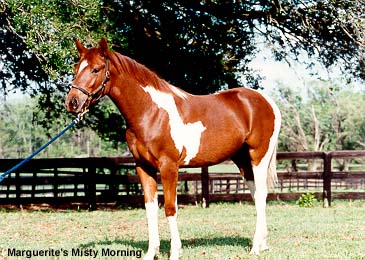
Chincoteague Pony

Introduction: If you have any comments or suggestions, please click here.
Names: Chincoteague, Chincoteague Pony (pronounced shinko-teeg). Sometimes called Assateague Pony; there is really no difference. Both are the names of the islands where they were found. I have also found at least one source that referred to this little fellow as the Maryland pony.
Origin: Chincoteagues are a wild race found off the coast of Virginia on the islands of Assateague and Chincoteague. A no-doubt related band roams the island of Okracoke off North Carolina. These island ponies are possibly descended from horses that survived the wreck of a Spanish ship in the 16th century.
Breeding: A feral breed originating in Colonial days and named after an island of that name lying off the coast of northern Virginia. Presently, the ponies live on a larger island, farther offshore than Chincoteague, called Assateague. The ponies are believed to be of Spanish origin. The original height was about 56 inches and the color was either bay, brown, black, or chestnut. During recent years the Chincoteague stock has been "diluted" by the infusion of Pinto, Shetland, and Welsh pony blood; and this has reduced the height to 48-54 inches. The resulting offspring, when tamed, are said to be gentle animals suitable for children's riding.
Description: Over generations of grazing on tough marsh grasses, the animals diminished in size to their present range of 12.2 to 13 hands. They may be of any color, though a solid color is considered a sign of the desert blood of their supposed ancestors.
Temperament: Intelligent and good-natured.
Features:
Uses:
Accomplishments:
Curiosities: Marguerite Henry has given an account of them in her classic book for children, Misty of Chincoteague. Once a year they are rounded up and herded across the channel from Assateague to Chincoteague and the foals are put up for auction. The ponies can now be found all over the United States.
Profiles:
Conclusion: